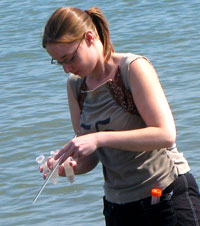|
|
The students undertook a wide range of studies involving local fish, water quality, little brown bats, and native plants.
“It’s wonderful to see the summer research students become so engrossed in their projects,” said Patricia Astry, chair of the Department of Biology and director and assistant professor of Medical Technology. “One of the students could hardly contain his excitement in his experiment.”
The various fellowships, awarded to undergraduate and graduate students supervised by biology department faculty, were generously endowed by the Holmberg Foundation, the Constantine Barker Fund, and the Biology Endowment Fund, through the Fredonia College Foundation.
“We hope that people from the campus community stop by to hear these wonderful presentations, and to catch some of the excitement the students have developed for their work,” Ms. Astry said. “From bats to bass to bacteria, with lots of stops in-between, it’s sure to be an interesting and informative afternoon.” Guests will have an opportunity to meet scholarship recipients at an informal reception to follow the presentations at approximately 4 p.m. Light refreshments will be served.
The source of E-coli in Lake Erie
Richard Boheen and Marie Thomas will present: “Microbial Source Tracking of Escherichia coli in Lake Erie.” Their project, directed by Dr. Ted Lee, identified the sources of bacteria that can contaminate water and result in closings of bathing beaches on Lake Erie. Mr. Boheen, of Fredonia, is a graduate student working toward a master’s degree in Biology. He earned his bachelor’s degree in Molecular Genetics and Chemistry at SUNY Fredonia. Ms. Thomas, of Lakewood, is a senior with a major in Molecular Genetics.
The sonar language of certain bats
Laura Lynn will present: “Little Brown Bats, Sonar Calls and Geographic Location: Is There a Sonar Call Dialect and Do Bats Pay Attention to It?” Her project, directed by Dr. Karry Kazial, addressed the role that sonar call dialects have in enabling bats to return to the same roosting location and maintain social relations from one year to another. Ms. Lynn, of Bernhard Bay, is a graduate student working toward a master’s degree in Biology. She earned a bachelor’s degree, also in Biology, from Paul Smith College
Native and alien plants near Canadaway Creek
Timothy Greco will present: “Effects of Japanese Knotweed on Cover and Growth of Introduced Native Species Near Canadaway Creek.” His project, directed by Dr. Jonathan Titus, addressed the impact that alien plant species have on native plants. Mr. Greco, of Amherst, is a senior with a major in Biology.
Genetics of local smallmouth bass
Cassidy Hahn and Nicholas Sard will present: “Genetic Divergence of Smallmouth Bass Populations in New York State Lakes and Tributaries” and “Fine Scale Genetic Divergence in Lake Erie’s Potadromous Smallmouth Bass Population.” Their project, directed by Dr. Timothy Strakosh, analyzed genetic information from smallmouth bass spawning in Lake Erie. That information will assist future conservation activities. Ms. Hahn, of Webster, is a graduate student working toward a master’s in Biology. Her bachelor’s degree in Biology was earned at SUNY Oswego. Mr. Sard, of Springville, is a senior majoring in Biology.
Are bats socially selective?
Jessica Pawlowski and Erica Stephens will present: “Does the Little Brown Bat Use Chemical Cues to Discriminate Between Individuals from Near and Far Roosting Sites?” Their project, directed by Dr. Kazial, assessed the use of chemical cues or signals released by individual bats in Chautauqua County to determine whether bats have capabilities of distinguishing other bats from near and far roosting sites based on the other bats' chemical signals. Ms. Pawlowski, of Silver Creek, is a senior majoring in Biology with a minor in Public Health. Ms. Stephens, of Nichols, is a senior Biology major.
Genetic engineering experiments
Patrick Paulot will present: “Insertion of Spearmint Gene Into Active Bacteria.” His project, directed by Dr. Wayne Yunghans, used genetic engineering techniques to attempt to insert a spearmint gene into specific bacterial cells, and then utilized other techniques to determine whether the gene had been successfully inserted. Mr. Paulot, of Lancaster, is a senior with a major in Medical Technology.
Restoring paddlefish to the Allegheny
Matthew Schillinger will present: “Assessment of Paddlefish Restoration in the Allegheny River System.” His project, supervised by Dr. Strakosh, measured the degree of success of paddlefish restoration efforts conducted by the Department of Environmental Conservation in the Kinzua area. Radio transmitters were surgically implanted in adult fish to monitor their seasonal movements. Assisting in the research were four undergraduate students: Jack Thayer, Vanessa Ricotta, Susan Pinkowski and Elora Esce. Mr. Schillinger, of Dansville, is a graduate student working on a master’s in Teaching. His undergraduate degree in Biology was earned at SUNY Fredonia.




